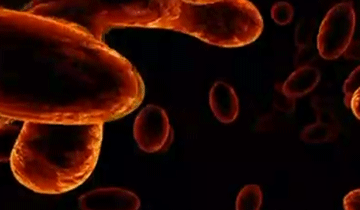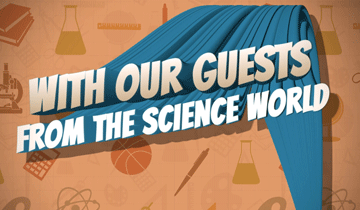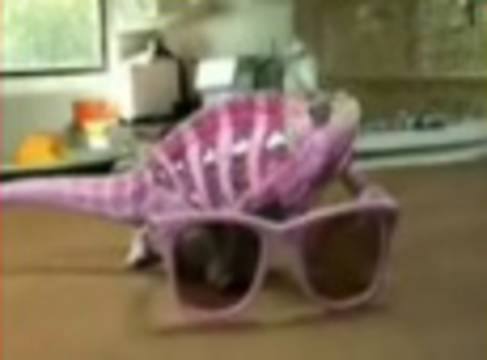Amazing Science 1
PRESENTER: Welcome to the first part of Science Today. In this program we will be reporting on the latest developments from the world of science and technology. We have spoken with experts on a range of fascinating subjects, from new techniques developed in the fight against cancer and newly discovered animals species to asteroids approaching the Earth and fossils dating back millions of years.
Before moving on to our reports, let us remember the words of Hazrat Ali; “Science raises the lowly, but ignorance brings down the lofty.”
Now let us set on this month’s tour of science in order for us to raise our mental horizons.
- A new drug in the treatment of cancer … The drug ChiLob 7/4 developed by British scientists works in a different way to traditional cancer treatments. To date, scientists have generally adopted methods that target the cancer cell. The aim of this new drug, however, is to strengthen the body’s immunity that is weakened by cancer cells and this to allow the body to fight the cancer cells themselves.
PRESENTER: As you know, the immune system is one of the most intelligent systems in our bodies. When a cancer cell starts multiplying, the body’s defense systems immediately go into action. Macrophages and T cells start destroying the cancerous tumor at great speed and with huge organization, before the person concerned is aware of anything. They generally succeed in that task. However, in one sense, cancer cells are anarchists. They recognize no rules. They constantly try to multiply and to enter other parts of the body by infiltrating the circulation and lymph systems. At that point, external intervention is required.
- The newly developed drug ChiLob 7/4 has been tested on 26 patients, and quite successful results have been obtained. The EU has therefore announced that it is setting aside 5 million euros for the scientists in the study.
PRESENTER: The aim of this new drug is to restructure the functioning of the marvelous defense system in our bodies. In one sense it adds more effective techniques to the body’s defensive strategies, suited to the potential of the enemy. Prof. Martin Glennie, the oncologist in charge of the laboratory studies, said that cancer cells could be targeted by increasing immune cells through vaccination.
PRESENTER: Our next report concerns a new technology that may give rise to very positive outcomes in treating cancer; a super-fine camera capable of visualizing a single cell.
- A new age had already dawned with the development of therapeutic techniques for examining the interior of the body through endoscopy using a mini-camera. Now scientists have gone one step further and have managed to create these mini-cameras as thin as a single hair. Thus super-thin camera will make it possible to also examine the brain. The technology developed by Joseph Kahn, a Stanford University professor of electrical engineering, and his team can show the glorious structure of the body’s cells at the micro level on screens, at very high resolutions.
So what are the advantages of this camera? We asked the Turkish brain surgeon Dr. Oktar Babuna what advantages this new technology camera offers for brain surgery.
DR.OKTAR BABUNA INTERVIEW: In addition to gaining doctors time in the diagnosis and treatment of diseases, it also reduces the risk of error to a minimum. Because the difference between this camera and previous technologies is the ability to visualize a single cell independently.
There is a glorious and extraordinary activity inside of our cells, which are approximately 1/1000 of a millimeter in size. Some 500 molecules pass in and out of the membrane around the cell nucleus alone. Let me give a comparison so we can better grasp the complexity of the traffic. Imagine 500 vehicles a second passing both ways through a freeway toll booth. But this happens so flawlessly that none of these 500 vehicles a second ever collide, obstruct one another or block the road. That sounds impossible, doesn’t it? But this huge flow of traffic continues every second in every one of the 100 trillion cells in our bodies.
When there is an abnormality in a cell, our aim is to observe this at the cellular level right from the outset. With present-day technology we can only detect a cancer cell when it reaches a size of half or one centimeter. With this (new technology) camera it is possible to detect diseases inside the cerebral blood vessels and other sensitive tissues right from the earliest stages.
PRESENTER: Newly developing technologies reveal the artistry in our creation in the most immaculate manner. As the world famous professor of mathematics Cahit Arf says, “Societies that are unable to produce science, and the technology that is a product of it, lose their independence, and thus their happiness.” And science helps us understand the flawlessness in the systems created by Allah much better, which in turn, . And that increase our love of Allah and happiness. Therefore, as Prof. Arf says, societies that think along these lines will surely enjoy higher levels of well-being and happiness.
PRESENTER: Our next report comes from the world of paleontology. A very well preserved scorpion fly fossil dating back 50 million years has been found. Let us now look at the details.
- A 50-million-year scorpion fly fossil has been found in the Cache Creek region of British Colombia in Canada, near the U.S. border.
This scorpion fossil fly, unearthed by a team led by Bruce Archibald from the Simon Fraser Institute in British Colombia, dates back to the Eocene period. There are currently two families of scorpion fly, four others having become extinct.
PRESENTER: 50 million years. It is amazing it should have survived so long, isn’t it? The reason why scorpion flies, which belong to the order Mecoptera, are referred to by that name is that they have sting-like organs. However, the females lack this organ. This newly discovered 50-million-year scorpion fly fossil shows that this life form has remained identical despite the passage of millions of years, and has not changed in the slightest. Behind me you can see the 50-million-year scorpion fly fossil, while on this screen you can see a present-day scorpion fly. They are identical, from their general structures to the pattern on their wings. Although they are separated by 50 million years, there is no difference between them, no evolution.
Let us continue with flies. But this time we are looking at mosquitoes, which we all know so well and whose buzzing is literally a symbol of summer. French scientists have for the first time managed to visualize the way a mosquito sucks blood in detail. Let us now look at these images, recorded by researchers at the Pasteur Institute in Paris, France.
- The mosquito carefully seeks out a blood vessel after inserting its mouthparts inside a living body. What is striking here is how the mosquito is able to act so freely inside the tissue. It inserts its needle at the angle it requires and literally drills between the cells.
After reaching a blood vessel it punctures it and starts sucking the blood. Its sucking power is so strong that the blood heads to its mouth with a huge force. The vessels sometimes collapse in on themselves because of the power of this vacuum. The study has shown that the blood sucking process takes an average of 4 minutes.
PRESENTER: Glorious!... Although the mosquito’s needle looks like a classic tube it is in fact covered with a sheath containing complex equipment and is known as the labium. We cannot see the sheath in this video because it changes shape at the moment the mosquito bites to reveal a glorious mechanism consisting of six separate parts. Four of these components are thin fibers that serve as blades, cutting the skin. We can see the sheath moving to the side as the needle enters the blood vessel. Saw-toothed knives appear once the sheath is opened. As these cut the skin they also keep it attached to the tissue. In this way, the mosquito is able to bring its other mouthparts up to the skin of its prey.
The needle, which looks like a single component in the video, actually consists of two parallel micro-tubes. The insect sends its saliva down of these, while it pumps the blood upward through the other. Yes, we are looking at a secret and wonderful creation in the details here.
Scientists had witnessed this magnificent functioning in the mosquito many times before, but this is the first time it had been recorded with the images you have just seen now. See how Dr. James Logan, an entomologists who studies mosquitoes, expresses his amazement after watching this video:
“I was genuinely amazed to see the footage. I had read that the mouthparts were mobile within the skin, but actually seeing it in real time was superb. What you assume to be a rigid structure, because it has to get into the skin like a needle, is actually flexible and fully controllable. The wonders of the insect body never cease to amaze me!”
PRESENTER: These new images, at which scientists are unable to suppress their amazement, have succeeded in to some extent resolving the mystery of the marvels in the insect world. However, the question of how the mosquito uses all this equipment in the most efficient way is also worthy of wide-ranging investigation.
PRESENTER: There now follows a report from the world of biacteria. Could light-emitting bacteria be a source of inspiration of alternative lighting systems of the future?
Three undergraduate students from the University of Wisconsin in the USA are planning to manufacture light without electrical energy in a closed ecosystem in a jar containing bacteria and fruit flies. In this research the students will copy the genetic code they take from light-emitting organisms such as fireflies into fruit flies. This will produce a natural light source inside the jar. However, in order to ensure the continuity of this mechanism, there also need to be bacteria inside the closed system that will use light to produce food and recycle waste.
PRESENTER: Zaiken et al., who are conducting the study, describe the greatest problem once all these things have been done as transmitting the genetic code for production of light to newly produced fruit flies. Because a genetic code that has not existed since an organism was created but that was added on afterward cannot be handed on to a new generation via reproduction. Genetic information can only be passed on to later generations if it is added to the reproductive cells. Zaiken and colleagues are now working on new methods for overcoming that obstacle.
And now we have the video that has attracted the most interest this month. Let us watch it together.
PRESENTER: Our next report comes from the world of astronomy. NASA has published a map of celestial bodies that pose a threat to the earth. Let us watch...
- NASA has published a map of the orbits of potentially hazardous asteroids. The orbits of these asteroids, which are at least 140 meters in diameter, pass approximately 7.5 km from the earth. Scientists have recorded a significant increase in the numbers of these heavenly bodies classed as Potentially Hazardous Asteroids, in recent years. Astronomers at NASA and other institutions are constantly working to produce more accurate information about whether these potentially hazardous bodies will pass by the Earth and the probabilities of their hitting it.
PRESENTER: According to statements by NASA, these asteroids are not expected to hit the earth this century. However, scientists offer no guarantee for after that. Meteors that fell to earth over Russia as small fragments after breaking up in the atmosphere created great excitement. Most recently, a meteor seen in 7 U.S. states in the final days of 2013 was recorded by amateur cameramen. Let us now look at those images.
PRESENTER: A new species has been added to the strawberry family, one of essential fruits of summer. So what are the characteristics of that species?
- A new species of strawberry has been discovered in Oregon, in the USA. Kim Hunter from the Agricultural Research Service discovered this new strawberry on the high slopes of the Cascade Mountains in Oregon. It has now been named the Cascade strawberry. This species grows between 900 and 1500 meters high and flowers in early July. The fruits mature over 2 weeks in August.
PRESENTER: There are more than 20 known species of strawberry, and now another has been added to the list. These strawberries all have one common characteristic, a 2:5 ratio in the sequencing of their leaves. Wherever you may go in the world, when you pick up a strawberry you will see this same ration in its leaves. Scientists refer to this as the golden ratio.
Strawberry leaves possess a special sequence known mathematically as the Fibonacci series. The feature of this series, known as the golden ratio and discovered by Fibonacci, a medieval mathematician, is that each number in the series represents the totals of the two preceding numbers.
This is the Fibonacci series. Let us now have a closer look at what these numbers represent.
The total of two consecutive numbers in the series determines the next number.
The total of 0 and 1 is 1. When you add 1 and 1 you get 2. 1 and 2 make 3. 2 and 3 make 5. 5 and 3 make 8, and so on.
The series runs 0, 1, 1, 2, 3, 5, 8, 13, 21, 34, 55, 89, 144, 233, 377, 610, 987, 1597, 2584, ...
When the numbers in the series are divided by the previous one, very similar results are obtained. For example, 3 divided by 2 is 1.5. 5 divided by s is 1.6. 8 divided by 5 is 1.6. This figure becomes permanent after the 13th number in the series. This is the number known as the golden ration, 1.618.
The Fibonacci numbers appear in the way that strawberry leaves are set out - 2/5. This ratio is the same in the newly discovered strawberry and in the leaves of the strawberries in your garden. Fibonacci numbers also appear when we look at the leaves of other plants. The spacing in almond tree leaves is 5/13, blackberries 1/3, linden leaves ½ and pear tree leaves 3/8. All these figures appear in the Fibonacci series. Astonishing, but true. Wherever you may go in the world, the ratio is the same in all linden tree leaves. In addition to plants, this wonderful ratio can also be seen in many other life forms in nature, as a marvel of creation.
Let us now turn from history to pre-history. To the world of the Neanderthals, who no longer exist. Neanderthal Man has attracted considerable interest because of his life style. The latest finding reveals their skill in leather working.
-Scientists have discovered a very special tool at an excavation of a Neanderthal site in France. This tool bears a close resemblance to the lissoirs used by top quality leather goods manufacturers today. The tool is used to make the leather more lustrous and waterproof. Four specimens were discovered in the excavation and are estimated to date back 51,000 years.
PRESENTER: Archeological findings had already shown that the Neanderthals possessed a developed form of social life. However, this latest finding has taken this understanding onto another level. Scientists used to think that the Neanderthals learned these techniques from the modern human beings they lived together with at the same time in Europe. However, this tool is 51,000 years old. Skeletons belonging to modern human beings in Europe date back 43,000 at the earliest. What this means is that the Neanderthals knew about and used these tools before they ever encountered modern human beings.
The conclusion from this excavation is that the Neanderthals were an intelligent, social and productive human race, just like human beings today. It is not hard to imagine that they used the leather they worked in such a quality and detailed way in various fields, from clothing to shelter.
Let us briefly review the reports to date concerning the high intelligence of the Neanderthals.
This is a report from a leading scientific web site from August 2008:
The caption reads “New Evidence Debunks 'Stupid' Neanderthal Myth”.
Now we come to September 2010. Another scientific report. The caption reads: “Neanderthals more advanced than previously thought: They innovated, adapted like modern humans, research shows”
And our 3rd caption. This comes from 3 December, 2013. It comes from a British newspaper and reads: “Neanderthal homes were tidy and organised: Ancient shelter reveals that living spaces were carefully divided into a kitchen and bedroom”
And there are others.
- Neanderthals could speak like modern humans, study suggests
- Neanderthals ... They're Just Like Us?
- Neanderthals Weren't Stupid
- Who you calling dumb? Neanderthals possibly cave artists
Scientific findings show that, contrary to popular opinion, the Neanderthals were creative enough to produce intelligently planned tools, were interested in arts such as music and painting and were a human race with powerful social relations.
So what is next?
PRESENTER: Our devoted friend, the dog, is both loyal and incredibly talented. But this is the first time I have seen such a skill as this.
And now we have cute animals whose acquaintance we first made last year. Let us have a look at this raccoon-like creature, that quickly became an internet phenomenon.
- Scientists have discovered a new species of mammal for the first time in 35 years. This tiny mammal was discovered last August in Andean jungle by Kristofer Helgen from the American Museum of Natural History and his colleagues. The scientists say that this animal, which they named the olinguito, had been seen in 2006 but had never been described as it had never been caught. The bones and skull of the animal are small and its teeth large. Its skeletal system resembles that of the raccoon, and it resembles a cross between a house cat and a bear cub in appearance.
PRESENTER: It is not surprising that thousands of new species are discovered every year. Scientists estimate that there are between 10 and 12 million species on earth. That does not include the micro-world. To date, just 2 million species have been described. The figures are amazing, aren’t they? The variety in the creation of life is absolutely stunning.
PRESENTER: We have no come to the end of this month’s program. Insha’Allah we will meet again with new subjects and ever more fascinating reports on our next program. Good bye.













